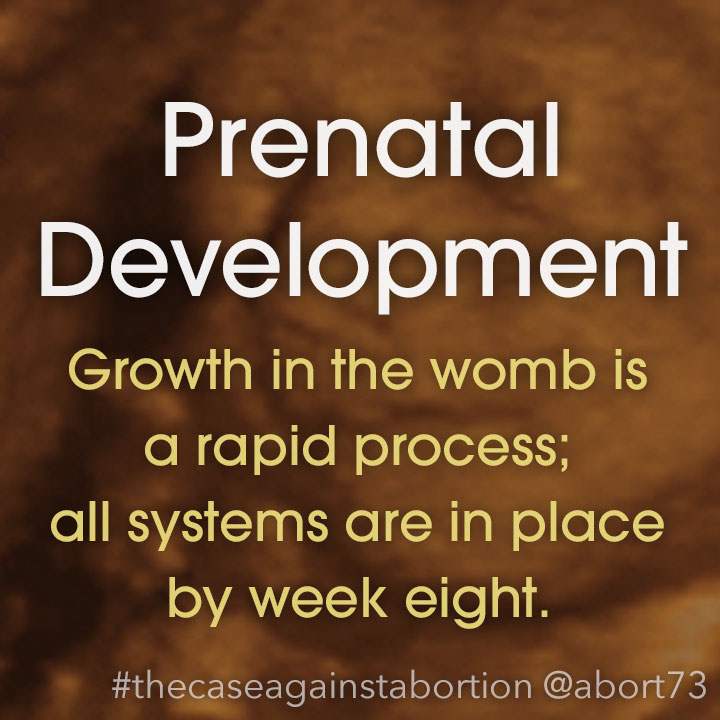Page Summary:
An accurate understanding of prenatal development makes it impossible to argue that abortion is the mere removal of undifferentiated cell tissue or that the developing embryo is simply a part of the mother's body.
For some people, the fact that human life begins at fertilization is enough to firmly establish the injustice of abortion. Others aren't so easily convinced. They might argue that even though human embryos and fetuses are human beings, they are not developed enough to be morally significant.
If we're honest, we must concede that there is a period of time following fertilization during which human beings do not look very human, or at least they don't look the way we expect human beings to look. In truth, a human blastocyst looks exactly as a human being should look, five days after fertilization. Nevertheless, it can be difficult to feel much emotional attachment to something that so little resembles a baby.
What most people don't realize is how quickly the developing human takes on the characteristics that are so familiar to us in human beings outside the womb. The rate of growth is astonishing. In fact, during the several days following implantation, the embryo doubles in size every day. If such rapid growth were maintained throughout the pregnancy, the baby would be larger than the sun at birth!1 In just six weeks time, the human embryo goes from looking like a "bunch of cells" to looking like a baby – though only a half inch tall!
In order to better understand why it is such a fallacy to argue that abortion is the mere removal of cell tissue, consider this timeline of prenatal development:
FERTILIZATION / CONCEPTION
At the moment of fertilization, a new and unique human being comes into existence with its own distinct genetic code. Twenty-three chromosomes from the mother and twenty-three chromosomes from the father combine to result in a brand-new and totally unique genetic combination. Whereas the heart, lungs, and hair of a woman all share the same genetic code, her unborn child, from the moment of fertilization, has a separate genetic code that is all its own. There is enough information in this tiny zygote to control human growth and development for the rest of its life. Until implanting into the lining of the uterus, each cell lives off of stored energy and newly manufactured DNA; at this stage in development the zygote is receiving no direct sustenance from the parents.
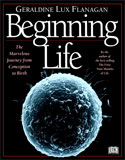
"In the hours of conception every aspect of the genetic inheritance for a new individual will be determined once and for all: to be a boy or girl, with brown, or with blue eyes, fair or dark, tall or short; all the rich detail of physical attributes from head to toes... The new genetic program is achieved when the two parent pronuclei come to lie side by side within the egg for perhaps a day, as their contents combine in the ultimate biological union of male and female. In the instant when the union is consummated, the whole egg substance divides into two entirely new cells, identical to one another. These are the first two cells of the baby-to-be. So begins the first day of the first nine months of life."
Geraldine Lux Flanagan, Beginning Life. New York: DK, 1996. pp. 14, 23.
IMPLANTATION
Renowned scientific author, Barry Werth, calls implantation (which he describes as "the joining of two lives") the "second great challenge of pregnancy, after fertilization."2 At about eight days after conception, the fertilized ovum (called a blastocyst) implants in the lining of the uterus. It emits chemical substances which weaken the woman's immune system within the uterus so that this tiny foreign body is not rejected by the woman's body. Were this tiny embryo simply "part of the woman's body" there would be no need to locally disable the woman's immunities. A few days after implantation, gastrulation begins. Gastrulation is the process by which the embryo is transformed from a simple ball of cells into a multi-layered organism. By folding in on itself, the basic body begins to take shape as cells differentiate into specialized cell types. Cells that will become the muscles, skeleton and gut actually begin on the outside, but during this dramatic migration will soon find their permanent home in the body's interior. Developmental biologist, professor and author, Lewis Wolpert, once said, "It is not birth, death or marriage, but gastrulation that is truly the most important time in your life."3
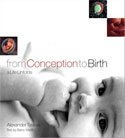
"The human immune system is programmed to distinguish between molecules that are 'self' and 'nonself' and to destroy the latter. The blastocyst, measuring less than one-hundredth of an inch acrros – a barely visible dot – behaves like a parasite, burrowing into the lining. Yet the uterus, after initially swelling to engulf the embryo and marshalling white blood cells to dispose of it, suddenly turns receptive, even acquiescent. Its blood vessels engorge with food and oxygen-bearing blood, and its tissues cordon off an area for the invader. Then, as the embryo bores through the small maternal blood vessels in its path, rupturing them, the hemorrhaging uterine tissues respond by releasing a starch that becomes its first meal. At once the embryo gorges itself and starts to grow at anstonishing speed – doubling daily in size. Before the expectant mother knows she is pregnant, the basic relationship between mother and child is forged."
Barry Werth, From Conception to Birth. New York, NY: Doubleday, 2002. p. 7.
ILLUSTRATED TIMELINE OF PRENATAL DEVELOPMENT (click image to enlarge)
Copyright © Nucleus Medical Art, Inc. All rights reserved. www.nucleusinc.com
3 WEEKS from fertilization (5 Weeks LMP)4
By the end of the third week of pregnancy, approximately 21 days after fertilization and 8 days after first taking shape, the heart starts beating. Over the next four days, the heart will settle into its regular rhythm and will start pumping blood throughout the embryo's newly formed blood vessels. It will continue to do so for an entire lifetime and will have beat roughly 54 million times before the baby is even born. The kidneys, at this point, are preparing for urine production, eye "bulges" become visible, and the brain begins dividing into three primary sections: forebrain, midbrain, and hindbrain. The arms and legs are also taking shape. Around day 26, arm buds are visible. By the 28th day, it is possible to distinguish between the upper and lower arm. The embryo is now surrounded and protected by the amniotic sac and is actually starting to produce the necessary cells for producing the eggs or sperm necessary for their own reproductive future.

"Over the course of the first trimester or first three months, the single egg will begin to transform itself into a fully formed baby. But all the features of the human body, nerves, organs, muscles, are mapped out in the fragile first weeks."
In the Womb, National Geographic, 2005.
4 WEEKS from fertilization (6 Weeks LMP)4
A month after fertilization, brain development rapidly speeds up. In just two days time (between day 31 and 33), the brain's size increases by 25 percent. It is estimated that during the course of prenatal development an average of one million neurons (impulse-conducting cells that make up the nervous system) are produced every minute. Hand formation begins around day 31. Two days later, the feet begin taking shape, the retina of the eyes gain pigment, and the nose starts to elevate.

"[The first month of life] will bring a marvelous transformation, the greatest developmental change of a lifetime. The hundreds of cells turn into many thousands and together they become ten thousand times larger than the early cluster had been. The wonder of it is that these myriad cells organize themselves into a human body with the beginnings of all its exquisitely specialized components, all in their right places and some already practicing their functions."
Geraldine Lux Flanagan, Beginning Life. New York: DK, 1996. p. 37.
5 WEEKS from fertilization (7 Weeks LMP)4
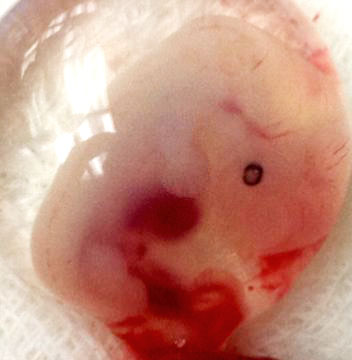
5-week embryo (ectopic pregnancy). Used with permission.
Permanent kidneys appear during the fifth week, and the external portions of the ear begin to differentiate. The fifth week will see the embryo more than double in size, growing from approximately 5 millimters in length (.19 inch) to 10 millimeters.
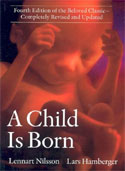
"[At] five weeks old, [the embryo] is well past the stage when it looks like a formless clump of cells. The skin layers are still barely developed, and the tiny body is quite transparent. The head and tail can be distinguished, as well as the heart, the vertebrae of the spinal column, and the beginnings of a tiny hand."
Lennart Nilsson and Lars Hamberger, A Child is Born, 4th edition. New York: Bantum Dell, 2003. p. 98.
6 WEEKS from fertilization (8 Weeks LMP)4
By the sixth week, the brain emits measurable brain impulses. Primitive brain waves have been recorded as early as six weeks and 2 days. Small bodily movements can be observed at this time, initially affecting the entire body but gradually becoming more specific. The embryo responds reflexively to stimulus and may be able to feel pain. Lars Hamberger, Professor and Chairman of the Department of Obstetrics and Gynecology at Sweden's Gothenburg University notes that, "even this early in pregnancy, the embryo is extremely lively, in constant motion, sleeping for only brief periods."5 Bone ossification has begun, lips have appeared, all 20 teeth buds are in the gums, the diaphragm has formed, the kidneys are producing urine and the stomach is producing gastric juices.
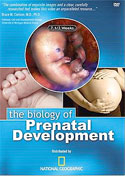
"By six weeks, the cerebral hemispheres are growing disproportionately faster than other sections of the brain. The embryo begins to make spontaneous and reflexive movements. Such movement is necessary to promote normal neuromuscular development. A touch to the mouth area causes the embryo to reflexively withdraw its head."
The Biology of Prenatal Develpment, National Geographic, 2006.
7 WEEKS from fertilization (9 Weeks LMP)4
Distinct leg movements can be seen after seven weeks; hiccups have also been observed. Female ovaries are identifiable and the 4-chambered heart has reached completion. Fingers and toes are distinctly separated, knee joints are present, and the embryo develops the ability to smell.

"Day 49 has been elected to be the final day of the scientifically recorded day-to-day diary of development. On this day, the embryo is seven weeks old and is considered to be essentially complete. The creative enterprise of prolific cell division, differentiation, streaming migrations, establishment of new cell communities, and specialization: these come to rest when the foundations for all the working parts of the body are in place."
Geraldine Lux Flanagan, Beginning Life. New York: DK, 1996. pp. 55, 56.
8 WEEKS from fertilization (10 Weeks LMP)4

Photo by Suparna Sinha. Licensed under a Creative Commons Attribution 2.0 License.
By the eighth week of pregnancy, every organ is present and in place. The embryonic period is now over. Ninety percent of the structures found in an adult human being can be found in this tiny embryo (now called a fetus) which is only about an inch and a half long. The brain, at this point, accounts for almost half of the body's total weight, and 75% of 8-week fetuses demonstrate right-hand dominance. Intermittent breathing motions (though there is no air present in the uterus) occur, and male testes are releasing testosterone. As the skin thickens, it loses much of its transparency. The photograph above of an 8-week fetus (10-weeks gestation) was taken by a medical student in India, immediately following the removal of the mother's uterus (after she was diagnosed with cervical cancer). It provides a rare glimpse of what developing human beings look during the early stages of pregnancy.

"Measuring one-and-one-fourth inches from crown to rump and weighing about one-thirtieth of an ounce, the (56-day-old) embryo is now all but fully formed. All body systems are in place and elaborated. Architecturally, the organism is more or less whole... Though the energy output is about one-fifth that of an adult, the heart is functionally complete... A great passage has been made."
Alexander Tsiaras, From Conception to Birth. New York, NY: Doubleday, 2002. p. 183.
PHOTOGRAPHIC TIMELINE OF PRENATAL DEVELOPMENT (click image to enlarge)
The prenatal photographs shown above were taken by famed Swedish photographer Lennart Nilsson and are displayed here for educational, non-commercial purposes in accordance with the doctrine of "fair use."
9 WEEKS from fertilization (11 Weeks LMP)4
The eyelids close at this point, and fetuses are now capable of sucking their thumb, swallowing amniotic fluid, grasping objects, responding to touch and even doing backward and forward somersaults. The uterus can be recognized in female fetuses and external genitalia become more recognizable.

"The baby becomes very lively [during the third month of pregnancy]. In the freedom of the watery pool the tiny being moves gracefully and with ease and progresses to outdo any newborn in acrobatic feats."
Geraldine Lux Flanagan, Beginning Life. New York: DK, 1996. p. 59.
10 WEEKS from fertilization (12 Weeks LMP)4
Rapid growth between 9 and 10 weeks increases body weight by 75 percent. Fingernails, toenails and unique fingerprints all appear at this time.

"The mother provides the shelter and the basics: food, water and oxygen, but the real star of the show is the fetus herself, building, dividing and growing according to a an intricate set of plans created at the moment of conception."
In the Womb, National Geographic, 2005.
16 WEEKS from fertilization
Though the fetus has long been in almost perpetual motion, by 16-20 weeks from fertilization, the body is large enough for the mother to start feeling the kicks. Eyelids have now completely covered the eyes, and fine hairs have begun to cover the entire body.

"The little fetus moves more and more every day, and the jerky body motions during the embryonic stage are now replaced by slower and aparently more goal-oriented movements. The hands often find their way to the mouth, ultrasound scanning shows, and the arms and legs are stretched and bent. The occcasional breathing movement also appears; the fetus can be seen to yawn or hiccough now and then and seldom lies perfectly still for any length of time."
Lennart Nilsson and Lars Hamberger, A Child is Born, 4th edition. New York: Bantum Dell, 2003. p. 122.
22 WEEKS from fertilization
Where modern medical services exist, twenty-two weeks from fertilization (24-weeks gestational age) is generally considered the beginning of viability outside the womb. At this point in pregnancy (barely half way through a full term) the odds of long-term survival are still relatively slim, but new medical advances continue to increase the likelihood of survival and decrease the age of viability.
3D AND 4D ULTRASOUND OF A TWENTY-FOUR WEEK FETUS (click image to enlarge)
Private collection. Used with Permission.
BIRTH
The fetus initiates labor by stimulating the adrenal cortex to secrete a hormone that induces the mother's uterus to begin contracting. It is the fetus who determines when it's time for birth. In the womb, babies of all nationalities look roughly the same. It is only towards the end of pregnancy that color variations become apparent. A baby's skin often appears pink when it is first born because the blood vessels are so close to the skin's surface. Final formation of skin, hair, and eye pigmentation requires exposure to light, something the baby doesn't have much access to in the womb.

"Where once it seemed that the mental development of a baby began at birth, now it appears that birth could be a relatively insignificant event in developmental terms."
In the Womb, National Geographic, 2005.
There has long been a common misperception that most abortions occur before the embryo or fetus is recognizably human. Day after day, thousands of aborting women wrongly believe that they're simply eliminating some undifferentiated human cell tissue. Because the general ignorance of prenatal development is so convenient to the abortion industry, it's not hard to guess why Planned Parenthood does so little to accurately educate their clients. Of course, even if human embryos didn't become so recognizably human in such a short amount of time, would that somehow change the ethics of abortion? Afterall, isn't it the height of injustice to abuse another member of the human community simply because they don't look the way we expect them to? Abortion is not the mere removal of cell tissue; it is the death of living, growing human beings.
This page was last updated on October 09, 2015. To cite this page in a research paper, visit: "Citing Abort73 as a Source."
- Alexander Tsiaras and Barry Werth, From Conception to Birth, (New York: Doubleday, 2002), 61.
- Ibid, 58.
- Quoted in “Lewis Wolport gives the miracle of life the hard cell”: Anjana Ahuja, “Lewis Wolport gives the miracle of life the hard cell,” The Sunday Times (UK), March 28, 2009, par. 1.
- Pregnancy is generally measured in gestational weeks which accrue from the first day of the woman’s last menstruation (LMP). Though it does not provide an accurate fetal age (which is roughly 2 weeks less than the gestational age), it is the simplest way for an OB/GYN to age a pregnancy.
- Lennart Nilsson and Lars Hamberger, A Child is Born, (New York: Bantam Dell, 2003), 101.
Footnotes
Possible Objection:
There is a difference between being alive and being a person. Abortion may kill a living human being, but it doesn't kill a person. There is much more to being human than mere biology.
To learn our response, continue to the next page: Rights of Personhood
Related Entries:
- Part of the Mother’s Body?: From conception onward, pregnancy involves two (or more) separate bodies.
- Are Sperm and Egg Cells Alive?: A fundamental change occurs to the sperm and egg during fertilization.
For Further Study:
- It’s All the Same: Why Early and Late-Term Abortion are Moral Equivalents (Abort73 Blog)
- Alexander Tsiaras: Conception to birth -- visualized: TED Talks / December 2010

